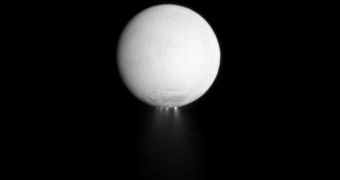A lot of ink has been spilled over the liquid ocean that is believed to exist below the icy crust of Saturn's moon Enceladus, and yet few observed the fact that the discussion shouldn't have existed at all.
We now take for granted that the geysers at the moon's South Pole emit water particles and organic molecules, and believe that these structures are fueled by a liquid ocean under the thick ice cover.
But what is is exactly that keep the ocean liquid? According to the basic laws of physics, Enceladus should have frozen stiff billions of years ago, when it was first created.
It is located a great distance away from the Sun, which means that its average surface temperatures reach nearly minus 200 degrees Celsius. Yet, an ocean of liquid water endures.
In a new scientific study, investigators look at why this happens, and come up with an interesting explanation. They say that wobbles in the moon's rotation patterns is what keeps its interior liquid.
The case of Enceladus is not unique in the solar system, in the sense that both Mars and Jupiter's moon Europa are believed to contain liquid water beneath their surface.
But the main issue separating the Saturnine moon from the other two bodies is size. Mars and Europa are sufficiently large (4,200 miles and 2,000 miles in diameter, respectively), to allow for liquid water.
But Enceladus, with its diameter of only 500 miles, is simply too small to make that possible. As such, experts had to turn to other factors to try and explain its ocean.
The moon also features insignificant amounts of radioactive elements, which are known for producing heat as they decay. So experts said that part of the reason why there is liquid water on the moon is that it is subjected to gravitational tides.
This means that Saturn is pulling so hard on its South Pole, that it is causing the cracks that the NASA Cassini orbiter identified on the icy space rock.
But this model alone is insufficient in explaining the amount of heat needed to keep Enceladus' ocean liquid, says NASA Goddard Space Flight Center (GSFC) expert Dr. Terry Hurford.
The discrepancies that still need to be covered can be accounted for by allowing for a slight wobble to affect the moon as it rotates. This process is called libration.
“Cassini observations have ruled out a wobble greater than about 2 degrees with respect to Enceladus' uniform rotation rate,” Hurford explains.
“Depending on whether the wobble moves with or against the movement of Saturn in Enceladus' sky, a wobble ranging from 2 degrees down to 0.75 degrees produces the best fit to the observed warmest zones,” he concludes.

 14 DAY TRIAL //
14 DAY TRIAL //